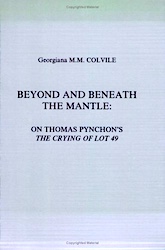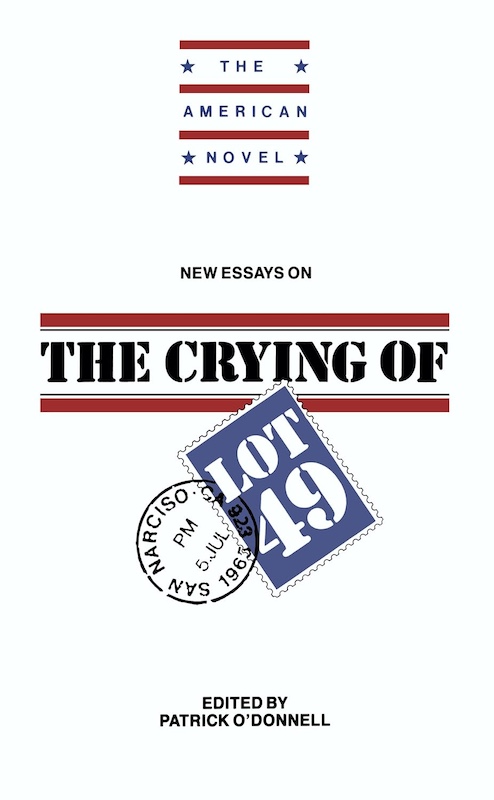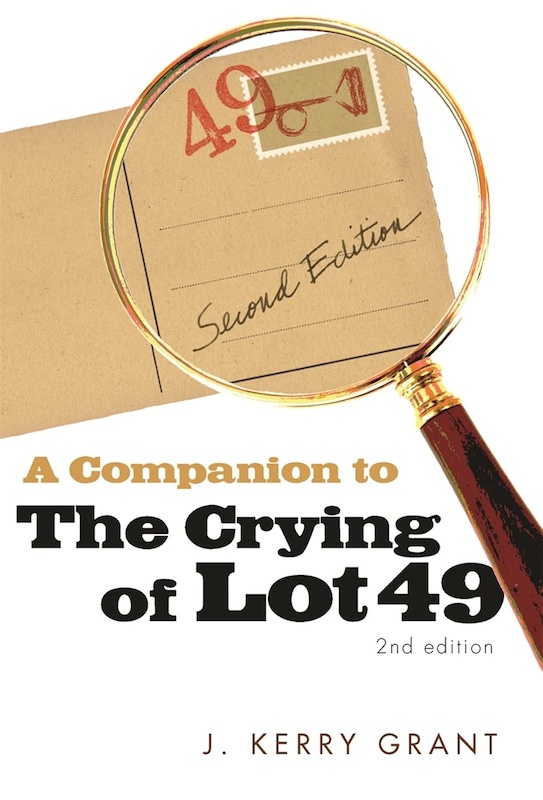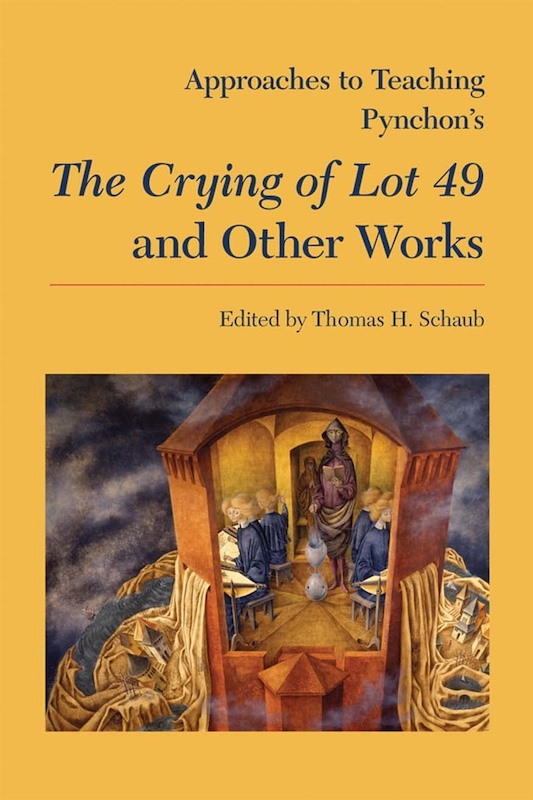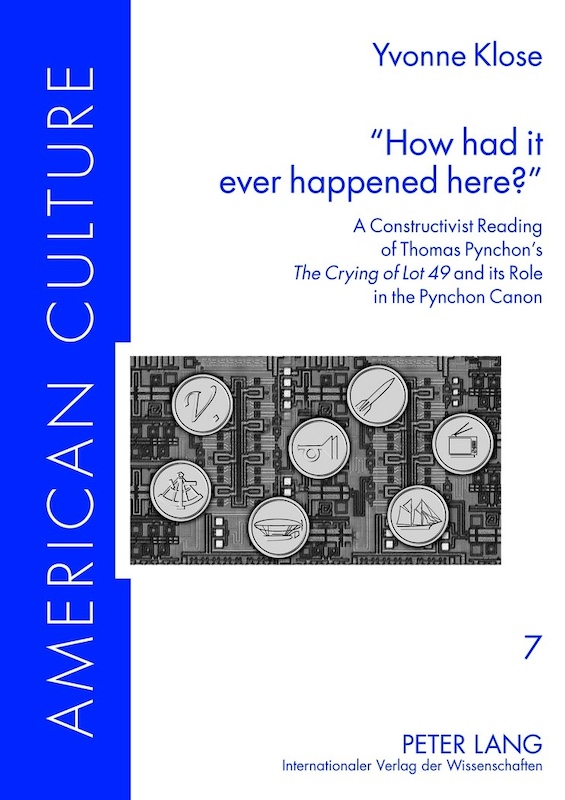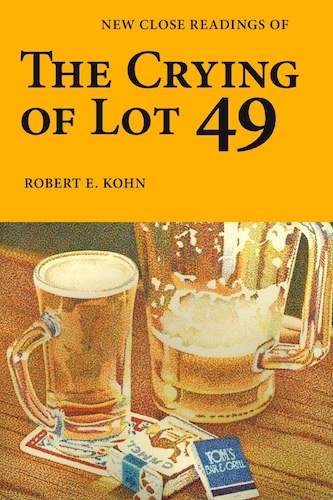Pynchon Criticism: “The Crying of Lot 49”
- At January 31, 2021
- By Spermatikos Logos
- In Pynchon, The Modern Word
 0
0
…prisoners in the top room of a circular tower, embroidering a kind of tapestry which spilled out the slit windows and into a void, seeking hopelessly to fill the void… —“The Crying of Lot 49”
Pynchon Criticism: The Crying of Lot 49
This page collects essays, analysis, and guides centering on The Crying of Lot 49, Pynchon’s second novel, published in 1965. Most of the books profiled in this section are accompanied by a brief description, a summary of contents, and the official publisher’s blurb. If any visitor would like to contribute informed commentary for any of these works, please contact Spermatikos Logos! The books are listed in chronological order of publication. Clicking the image of a book takes you directly to Amazon.
Beyond and Beneath the Mantle: On Thomas Pynchon’s The Crying of Lot 49
Rodopi Bv. Editions, 1988.
The work is volume 68 of the Costerus New Series. We have no additional information about this book, and welcome any elaboration or reviews.
New Essays on The Crying of Lot 49
Cambridge University Press, 1992
Publisher’s Description: The Crying of Lot 49 is widely recognized as a significant contemporary work that frames the desire for meaning and the quest for knowledge within the social and political contexts of the ‘50s and ‘60s in America. In the introduction to this collection of original essays on Thomas Pynchon’s important novel, Patrick O’Donnell discusses the background and critical reception of the novel. Further essays by five experts on contemporary literature examine the novel’s “semiotic regime” or the way in which it organizes signs; the comparison of postmodernist Pynchon and the influential South American writer, Jorge Luis Borges; metaphor in the novel; the novel’s narrative strategies; and the novel within the cultural contexts of American Puritanism and the Beat movement. Together, these essays provide an examination of the novel within its literary, historical, and scientific contexts.
A Companion to The Crying of Lot 49
University of Georgia Press, 2001
Publisher’s Description: The Crying of Lot 49 is Thomas Pynchon’s most accessible work and perhaps the one most widely read and taught. Nonetheless, the novel poses many challenges with its impressive range of references to contemporary popular and material culture, history and geography, and slang and technical jargon. This expanded and updated companion to the novel contains more than five hundred notes keyed to the 2006 Harper Perennial Modern Classics, the 1986 Harper Perennial Library, and the 1967 Bantam editions. The majority of notes are interpretive, although some are designed to provide a historical context or to recover the meaning of a reference that, over time, has proved ephemeral. This new edition adds quotations and paraphrases drawn from criticism published since 1994, thus adding more than seventy new entries to the list of works cited. More than fifty annotations have been added and some eighty annotations have been expanded.
Approaches to Teaching Pynchon’s The Crying of Lot 49 and Other Works
Modern Language Association, 2008
Publisher’s Description: As teachers well know, the elements that make Thomas Pynchon exciting to read and study―the historical references, the multilayered prose, and the postmodern integration of high and low cultures and science and literature―often constitute hurdles to undergraduate and graduate readers alike. The essays gathered in this volume turn these classroom challenges into assets, showing instructors how to make the narratives’ frustration of reader expectations not only intellectually rewarding but also part of the joy of reading The Crying of Lot 49, Gravity’s Rainbow, Mason & Dixon, and other Pynchon works, short and long. Like all volumes in the “Approaches to Teaching” series, the collection opens with a survey of original and supplementary materials. The essays that follow offer an array of classroom techniques: among them, ways to contextualize the novels in their historical settings, from Puritan America through World War II and the volatile 1960s; to use the texts to explore racial and gender politics and legacies of colonialism; and to make Pynchon’s elaborate prose style accessible to students. Teachers will also find sample syllabi for courses solely on Pynchon as well as suggestions for incorporating his work into graduate and undergraduate classrooms at a range of institutions.
“How had it ever happened here?”: A Constructivist Reading of Thomas Pynchon’s The Crying of Lot 49 and Its Role in the Pynchon Canon
Peter Lang GmbH, Internationaler Verlag der Wissenschaften, 2012
Publisher’s Description: “How had it ever happened here?”, Thomas Pynchon’s protagonist Oedipa Maas asks towards the end of his second novel The Crying of Lot 49. This question is taken up in this book to explore Pynchon’s novels in the light of constructivist theory. It begins with a detailed reading of The Crying of Lot 49, which is carried into readings of Pynchon’s other novels (V., Gravity’s Rainbow, Vineland, Mason & Dixon, Against The Day, and Inherent Vice). All are shown to critically deal with the social construction of reality as a central theme, and a development of this theme is traced throughout Pynchon’s novels.
New Close Readings of The Crying of Lot 49
CreateSpace Independent Publishing Platform, 2013
This work of independent scholarship was self-published by a retired economics professor. As Kohn openly admits in the introductory pages, all but two of the essays were rejected for publication in established literary journals. There’s an interesting mix of pathos and flintiness in Kohn’s defense of his work, along with a disarming honesty: he admits that “time is closing in on me,” and spares the reader no details of his trials and tribulations with the literary establishment. The essays themselves are a mixed bag—Kohn frequently overreaches, and tends to see connections where others may see only his personal interest in disparate subjects. The reader is also struck by Kohn’s propensity for apophenia and paranoia: for instance, Kohn openly admits that he once believed the Tibetan seal on the dust jacket of Against the Day was a “personal communication” meant for Kohn himself! Nevertheless, one has to admire his cranky determination, which wouldn’t seem out of place in a Pynchon character. Indeed, there are times when Kohn’s book reads like a real-life Pale Fire, and the glimpses into the author’s character are significantly more entertaining than the essays themselves.
Publisher’s Description: This book provides numerous new interpretations of Thomas Pynchon’s The Crying of Lot 49, arguably the most epistemologically complex novel, page for page, ever written. One of the continuing surprises of the 1960s was that such a novel was destined to become a blockbuster. The continual flow of new editions demonstrates that The Crying of Lot 49 has remained a major seller well into the first decade of the 21st century. It is not surprising that J. Kerry Grant reported that some “Forty years after its first publication, The Crying of Lot 49 is still selling at the rate of between fifteen and twenty thousand copies annually.” Kohn’s close readings of Pynchon’s novel draw on writings by Henry Adams, Roland Barthes, Rachel Carson, Charles Darwin, Loren Eiseley, W.Y. Evans-Wentz, E.M. Forster, Don DeLillo, F.R. Leavis, Paul Virilio and Jerry Wilkerson.
Pynchon Criticism: [Main Page | General 1974–1999 | General 2000–Present | V. | Crying of Lot 49 | Gravity’s Rainbow | Mason & Dixon | Against the Day | Shorter Works | Contextual | Bibliography]
Author: Allen B. Ruch
Last Modified: 3 September 2024
Main Pynchon Page: Spermatikos Logos
Contact:quail(at)shipwrecklibrary(dot)com
Last Modified: 3 September 2024
Main Pynchon Page: Spermatikos Logos
Contact:quail(at)shipwrecklibrary(dot)com


